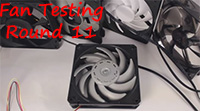As part of my “In-progress” 360 radiator testing, I’ve started this summary post where I will continue to update as radiators are tested.

SPONSORS
A special thanks to my many sponsors:
Danger Den sponsored the Hardware Labs GTX 360 and Hardware Labs SR1 360 radiators as well as the MC-TDX waterblock.
Aqua Computers sponsored the Aqua Computer’s flow meter.
Swiftech sponsored the MCR320 QP(Quiet Power), MCR320 XP (Extreme Performance) radiators as well as the MCP-35X2 pump.
XSPC sponsored the XSPC RS360, and XSPC RX360 radiators.
Aquatuning sponsored the Alphacool NexXxoS Pro III 360, Alphacool NexXxoS XT45 Full Copper 360, Alphacool NexXxoS XT60 Full Copper 360, and Phobya G-Changer 360 radiators.
EK sponsored the EK Coolstream XT360 and Coolstream XTX360 radiators
Coolgate sponsored the Coolgate Single Row Acrylic 360, the HD 360, and the triple row 360.
Test Bench


Restriction
Generally most radiators are low in restriction relative to your average and even lower restriction CPU block. Also in general the double thickness radiators usually have the lowest restriction due to the additional tubes where water can flow, but there are some exceptions such as the GTX which uses thinner than typical tubes.

Thermal Performance

Conclusion
Well 16 radiators done and as usual with most watercooling, the differences between radiators is also very small. When only 6 watts separates the top 11 radiators at 600RPM, testing error alone does become a problem. On the little bit of error checking I’ve done on a few radiators I am seeing in the neighborhood of 2-3 watt error present in my trendline results. You should also consider the scale of those 6 watts when a very small thing like switching out your pump from a D5 to DDC could likely yeild you that 6 watts reduction in heat.
.
With that I would say generally the thermal performance differences are relatively small, but there are some generalities:
- Copper Tubes are better than Brass Tubes
- Thicker radiators generally can be tuned for a broader range of RPMs than thinner
- Thicker radiators can perform better than thinner radiators, but the difference is not more than 5-10% typically
- Flat tubed radiators perform better than round tubed radiators
- Slim 30mm radiators can be tuned to perform extremely well in specific areas, but generally that means loosing more in the opposite area (ie a high speed tuned slim radiator won’t perform well at slow speeds)
- Build quality does vary and here you do get what you pay for.
- In performance, you don’t get what you pay for.
- Slow Speed Value = Alphacool ST30
- All Around Value = XSPC RS360
- High Speed Value = Swiftech MCR320-XP
- Slow Speed Performance = Alphacool ST30, HWlabs SR-1, and the neighboring top 6 are all really really close.
- All Around Performance = Alphacool UT60 & EK XTX are both really good all around performers
- High Speed Performance = Swiftehc MCR320-XP, Alphacool UT60, and the EK XTX are all great higher speed performers
- Hardware Labs GTX & SR1
- Aquacomputers AMS
- Several other close runners up.
- Alphacool UT60,XT45,ST30 & Phobya G-Changer for having that screw protector feature. Also extra ports and bleed screw on the UT60.
- Aquacomputers AMS for the modularity features.
- Aquacomputers AMS for it’s solder free and round tube construction and bare copper core
- Coolgate Copper Radiators for their copper plating finish and the Acrylic for it’s clear end tanks.
Cheers!
Martin








[…] […]
VERY interesting indeed Martin. That has given me food for thought when i am recommending a RAD. to my customers most of which think a thicker RAD. is always better.
Thanks, Yes extra thickness isn’t always better. It does generally mean a more broad range of good performance and really can help at high speeds, but under very slow speed conditions a slim rad can do as good or better if slow enough.
[…] sind in meiner Sig. verlinkt oder hier: 360 Radiator Shootout Summary | martinsliquidlab.org Verkauf/Tausch – Update 24.05.13: ASUS 13" Zenbook Prime, EVGA GTX 680, mech. Tastatur, […]
Hello there! I know this is somewhat off topic but I was wondering which blog platform are you
using for this website? I’m getting fed up of WordPress
because I’ve had problems with hackers and I’m looking at options for another platform.
I would be awesome if you could point me in the direction
of a good platform.
This is WordPress hosted by wordpress. Never had much trouble myself. Costs a little more than other options but it seems pretty solid.
[…] […]
Martin could you also mention the thickness / exact length of the rads? IT could be usefull to add since i want to buy all UT60’s now, but i’m not sure if they 3 fit in my 900D with 2 PSU’s installed.
[…] back 120 heres a good readup abt how much watt of heat certain rads can dissipate at certain rpms: 360 Radiator Shootout Summary | martinsliquidlab.org (adsbygoogle = window.adsbygoogle || []).push({}); Project O.R.A.N.G.E. Motherboard: Gigabyte […]
[…] extract W/10DeltaT numbers from fast_fate’s testing that meant we could compare results with Martin’s excellent Radiator round up from a few years […]